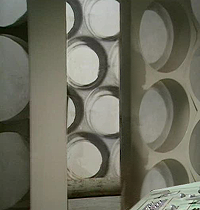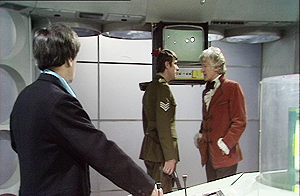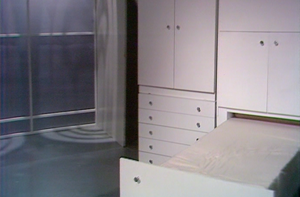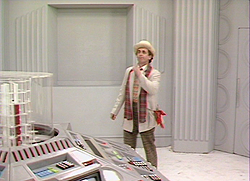 |
|
Home
creative
things
|
 |
| |
 |
research and facts
|
 |
| |
 |
images and misc
|
 |
| |
 |
archives of long ago
|
 |
| |
|
|
Patrick Troughton inherited a TARDIS set from William Hartnell which continued to be used in his early seasons without much modification. The standard sets of walls (sans their deep roundel backing) were used to construct minimal sets for short sequences which toped and tailed their adventures. The standard sets of walls (sans their deep roundel backing) were used to construct minimal sets for short sequences which toped and tailed their adventures.
In his second season The Abominable Snowmen sequence featured an unusual scanner assembly in which a framework was erected in front of a set of three free-standing computer blocks (pictured right). This maintained a rough tradition of having a main rear wall (or two) with roundels, the door on the left, and a computer wall on the right.
 A similar setup was employed for The Wheel in Space when Zoe was shown a repeat of Evil of the Daleks on the scanner screen, but for this scene, the scanner was mounted above the computer panels, high up in the wall. One of the deep roundels was also used like a cupboard with a circular door, behind which the Doctor's thought-device was kept. A similar setup was employed for The Wheel in Space when Zoe was shown a repeat of Evil of the Daleks on the scanner screen, but for this scene, the scanner was mounted above the computer panels, high up in the wall. One of the deep roundels was also used like a cupboard with a circular door, behind which the Doctor's thought-device was kept.
 But when production difficulties occurred on The Dominators it required the following story The Mind Robber to have an additional episode added. With no money available for additional sets, the cheapest solution was to have the episode almost entirely inside the TARDIS. But when production difficulties occurred on The Dominators it required the following story The Mind Robber to have an additional episode added. With no money available for additional sets, the cheapest solution was to have the episode almost entirely inside the TARDIS.
Aside from the sleeping quarters which had been shown to adjoin the control room in early Hartnell stories, the extent of the ship had never been revealed, and there was no suggestion up til this point of a vast interior to the TARDIS. The Mind Robber was the first time for some years that any other rooms were shown to exist in the ship and studio recording on 21st June included a scene in the newly devised "Power Room". This new area was only a little distance from the control room down a short corridor and it represented a first in which we saw an exit from the main  control room which actually suggested further unseen rooms to explore (although Susan did once remark on a vast TARDIS wardrobe which was later realised quite dismally in The Space Museum). The interior door featured a strange adornment with a circular motif, and suddenly the scanner had become mounted over this exit (pictured above right). control room which actually suggested further unseen rooms to explore (although Susan did once remark on a vast TARDIS wardrobe which was later realised quite dismally in The Space Museum). The interior door featured a strange adornment with a circular motif, and suddenly the scanner had become mounted over this exit (pictured above right).
Due to afforementioned budgetary issues the room (pictured left) was a fairly plain set of walls with stock equipment mounted on, and a prop at the centre which had appeared many times in  Doctor Who, most recently in The Wheel in Space. Doctor Who, most recently in The Wheel in Space.
When Patrick Troughton's tenure came to an end, his final adventure boasted a larger TARDIS set than had featured for some time, plus a return to the full computer wall from the start of the Hartnell era. The scanner was once again mounted in front, but this time suspended from the ceiling (pictured right). The larger control room also featured the large, hexagonal floor decoration surrounding the console.
 With the new, third Doctor being Earth-bound, the TARDIS set was mothballed for some time. Following its use for The War Games on 12th June 1969, it wasn't seen again until January 1970 for recording The Claws of Axos. For this story, Jon Pertwee's Doctor was given a brand new console, and it was mounted within an ageing set. One strange feature of this story is that the monochrome photographic blowup roundel wall was visible through the doors in what should have been the outside world (pictured left). With the new, third Doctor being Earth-bound, the TARDIS set was mothballed for some time. Following its use for The War Games on 12th June 1969, it wasn't seen again until January 1970 for recording The Claws of Axos. For this story, Jon Pertwee's Doctor was given a brand new console, and it was mounted within an ageing set. One strange feature of this story is that the monochrome photographic blowup roundel wall was visible through the doors in what should have been the outside world (pictured left).
 When the TARDIS was used for recording Colony in Space on 5th March 1971 it was Jo Grant's first time inside the ship and the last time the monochrome photographic blowup was used (pictured right). When the TARDIS was used for recording Colony in Space on 5th March 1971 it was Jo Grant's first time inside the ship and the last time the monochrome photographic blowup was used (pictured right).
The console and set then went into storage for over six months and was wheeled out again for the first story of Pertwee's third season. For studio on 4th October 1971 the console was once again dislocated from its mothership as the Doctor was seen to work on it in some generic UNIT room. Three months later, for a short scene in Curse of Peladon a minimal set was constructed using the same elements, and since no TARDIS scenes were required in the following story, January 17th 1972 would mark the final appearance of this guise of the console room.
 For the season nine finale The Time Monster, a new set was seen for the Master's TARDIS. In a redesign by Tim Gleeson the walls were modified so that the roundels were filled with bowl-shapes. This was in fact a re-dressing of the usual walls dating from 1963. The right-hand wall which contained the outside door was a new section with a saw-tooth opening and a "plug" pushed back. The entrance was via the right-hand side of the door-frame (shown left) and the entire "plug" moved forward when the door was in the closed position. For the season nine finale The Time Monster, a new set was seen for the Master's TARDIS. In a redesign by Tim Gleeson the walls were modified so that the roundels were filled with bowl-shapes. This was in fact a re-dressing of the usual walls dating from 1963. The right-hand wall which contained the outside door was a new section with a saw-tooth opening and a "plug" pushed back. The entrance was via the right-hand side of the door-frame (shown left) and the entire "plug" moved forward when the door was in the closed position.
 The next surprise was that the Doctor also had a new TARDIS interior which by chance now looked exactly like the Master's new design, but the Doctor brushes it off as a "spot of redecorating." A new element to this construction was a canopy at the rear of the set which functions as a partial ceiling. On the underside were a series of unreachable controls (which can be seen above right). The next surprise was that the Doctor also had a new TARDIS interior which by chance now looked exactly like the Master's new design, but the Doctor brushes it off as a "spot of redecorating." A new element to this construction was a canopy at the rear of the set which functions as a partial ceiling. On the underside were a series of unreachable controls (which can be seen above right).
Despite the effort which went into the refurbishment of the walls, this layout of the control room would never be used again.
And so when Doctor Who returned to celebrate its Tenth Anniversary year the TARDIS set was reconfigured once more.
 Although Roger Liminton is credited with the design, it recycles the same walls and ceiling blocks from The Time Monster (but with the bowls removed to return them to their 60s style) and the whole room is an attempt to replicate the original Peter Brachacki look. To this end, a new rear wall was constructed which featured a set of ceiling-mounted circular grilles, and the floor was also revamped with a large hexagon surrounding the console. The far-right wall was barely seen but instead of the clear-backed roundels, a CSO-blue-coloured panel was used to in-fill the holes. Although Roger Liminton is credited with the design, it recycles the same walls and ceiling blocks from The Time Monster (but with the bowls removed to return them to their 60s style) and the whole room is an attempt to replicate the original Peter Brachacki look. To this end, a new rear wall was constructed which featured a set of ceiling-mounted circular grilles, and the floor was also revamped with a large hexagon surrounding the console. The far-right wall was barely seen but instead of the clear-backed roundels, a CSO-blue-coloured panel was used to in-fill the holes.
The next time the TARDIS interior was seen properly was in Planet of the Daleksfor which a parade of new and perhaps slightly improble facts are presented about the interior of the time machine.
 Perhaps the most surprising thing to discover about the TARDIS at this point was that one corner of the control room contains a white wardrobe and chest-of-drawers unit. The bottom section of the unit opens up to reveal a bed - perhaps answering the long-standing question about where the Doctor may sleep. Above the bed in a cupboard (which Jon Pertwee isn't fooling anyone by calling a "locker") is a small recording unit which acts as the TARDIS log - another concept never previously mentioned. Whilst at first glance the bed might seem surprising, a fold-out sleeping compartment is entirely in keeping with what was seen in the Hartnell TARDIS in the early story The Edge of Destruction. Perhaps the most surprising thing to discover about the TARDIS at this point was that one corner of the control room contains a white wardrobe and chest-of-drawers unit. The bottom section of the unit opens up to reveal a bed - perhaps answering the long-standing question about where the Doctor may sleep. Above the bed in a cupboard (which Jon Pertwee isn't fooling anyone by calling a "locker") is a small recording unit which acts as the TARDIS log - another concept never previously mentioned. Whilst at first glance the bed might seem surprising, a fold-out sleeping compartment is entirely in keeping with what was seen in the Hartnell TARDIS in the early story The Edge of Destruction.
 The next idea presented is patently ludicrous. We are lead to believe that if the outer shell of the ship becomes coated in green jizz, then the occupants suffocate in about four minutes. This suggestion that the TARDIS uses some kind of osmosis for taking in oxygen from outside fails to address the fact the ship can float in space for an indefinite period with no problems, and secondly it ignores the huge volume of oxygen within the control room alone - and that's assuming there isn't a labyrinth of corridors and rooms elsewhere. Nevertheless, despite this nonsense, there is a handy emergency supply for just such a ridiculous scenario. The next idea presented is patently ludicrous. We are lead to believe that if the outer shell of the ship becomes coated in green jizz, then the occupants suffocate in about four minutes. This suggestion that the TARDIS uses some kind of osmosis for taking in oxygen from outside fails to address the fact the ship can float in space for an indefinite period with no problems, and secondly it ignores the huge volume of oxygen within the control room alone - and that's assuming there isn't a labyrinth of corridors and rooms elsewhere. Nevertheless, despite this nonsense, there is a handy emergency supply for just such a ridiculous scenario.  A small white box on wheels which we've never seen before happens to be lying around, which contains three utterly useless compressed air empty cylinders (pictured above left). A small white box on wheels which we've never seen before happens to be lying around, which contains three utterly useless compressed air empty cylinders (pictured above left).
One other small detail of note is that behind the main wall at the rear of the room, something can clearly be seen through the roundels on the floor (pictured right). This hints - not for the first time - that the rear wall is merely a partition and there is a second room adjoining the control room.
Several stories then passed once again without need of a TARDIS set until once again a Terry Nation script required it. Despite the lengthy sequences set inside the ship, only a minimal set was constructed for Death to the Daleks on 4th December 1973. This time the roundels were backed with a grey board and not back-lit in order control the light levels when all the ship's power was drained away. This story also revealed that when devoid of power, a crank-handle could be used to manually open the doors.
 There followed another long period without any sight of the TARDIS, during which Tom Baker became the Doctor. It wasn't until his second season that this new incarnation was seen inside his ship. For the occasion a new, third console was built, but the set itself was a recycling of the sixties deep roundels plus the shallow roundels and ceiling canopy first seen in The Time Monster (pictured left). There followed another long period without any sight of the TARDIS, during which Tom Baker became the Doctor. It wasn't until his second season that this new incarnation was seen inside his ship. For the occasion a new, third console was built, but the set itself was a recycling of the sixties deep roundels plus the shallow roundels and ceiling canopy first seen in The Time Monster (pictured left).
 The new console was only seen in one more story before it was side-lined by producer Philip Hinchcliffe in favour of a Jules Verne-style room. This new console room was wooden (or at least, wood-effect) and had unusual arrangements of roundels in regular square patterns, not hexagons (pictured right). The new console was only seen in one more story before it was side-lined by producer Philip Hinchcliffe in favour of a Jules Verne-style room. This new console room was wooden (or at least, wood-effect) and had unusual arrangements of roundels in regular square patterns, not hexagons (pictured right).
 A new element of the TARDIS design was a pair of grooved pillars (pictured left), along with a large scanner mounted in the wall with vertical shutters. For the new set a new console was built. It was considerably smaller than usual and contained within a railing. A new element of the TARDIS design was a pair of grooved pillars (pictured left), along with a large scanner mounted in the wall with vertical shutters. For the new set a new console was built. It was considerably smaller than usual and contained within a railing.
The real console was kept in storage until it returned after two years for the first story of the recording block for Season 15, eventually shown second in the season.  For this return, the prop was heavily refurbished almost beyond recognition, and for its appearance The Invisible Enemy an entirely new TARDIS set was constructed which would accompany the era of the new producer Graham Williams. This set used the same moulded style of roundel created for the wooden verson, but laid out in the typical hexagon arrangement. The grooved columns were recycled into the new design and resprayed grey. The type of shuttered scanner was also retained, but without the ornate-style frame. Overall, the new white control room set owed much to the Victorian one which it replaced. For this return, the prop was heavily refurbished almost beyond recognition, and for its appearance The Invisible Enemy an entirely new TARDIS set was constructed which would accompany the era of the new producer Graham Williams. This set used the same moulded style of roundel created for the wooden verson, but laid out in the typical hexagon arrangement. The grooved columns were recycled into the new design and resprayed grey. The type of shuttered scanner was also retained, but without the ornate-style frame. Overall, the new white control room set owed much to the Victorian one which it replaced.
The script gave recognition to the change of set with Leela carrying the hatstand back into the control room and commenting that they'd never been in there before.
The new room was considerably smaller than it had ever been before, with the console positioned much closer to the rear wall, providing a very claustrophobic feel (pictured right). The rear wall consisted of two panels of smaller, back-lit roundels which were jointed at an angle, and the a blank vertical strip consealed where they met. Large, grooved pillars were incorporated into the design, and a large scanner screen was mounted into the wall, with vertically closing shutters.
 This version of the control room lasted throughout seasons 15, 16, and 17, before incoming producer John Nathan-Turner oversaw a revamp when his tenure began. For the story of Meglos, the rear wall was given an extra panel featuring two vertical columns of roundels framed by smaller columns (pictured left). This removed the unsightly covered-joint which had always appeared very centrally in the previous version. The scanner and other elements of the set were retained. This version of the control room lasted throughout seasons 15, 16, and 17, before incoming producer John Nathan-Turner oversaw a revamp when his tenure began. For the story of Meglos, the rear wall was given an extra panel featuring two vertical columns of roundels framed by smaller columns (pictured left). This removed the unsightly covered-joint which had always appeared very centrally in the previous version. The scanner and other elements of the set were retained.
In Meglos the walls were revamped to remove the unsightly joint between two walls, which was covered by a thick strip. Instead, two vertical columns of roundels became the main centre wall at the rear (above right). This version of the set remained almost entirely unchanged until a one-off change for the final story of Peter Davison's first season.
For Time Flight's studio work on 1st Feb 1892 the middle wall was expanded so that instead of the two vertical columns, a whole section of the normal hexagonal arrangement was incerted (pictured right). A new, right-hand wall also now featured four columns of roundels and, along with the console positioned nearer the camera, this configuration of the set made the TARDIS look much more spacious again.
Disappointingly, however, when the TARDIS set was reconstructed for Snakedance two months later, the old version returned, with two vertical columns at the back. And so it remained for the rest of season 20.
 For the show's 20th anniversary story, The Five Doctors, not only saw a new fourth console created, but also the walls of the set were redesigned slightly. New, square columns replaced the old semi-circular ones, and the scanner section of wall was broadened and more grooved-decoration was added. For the show's 20th anniversary story, The Five Doctors, not only saw a new fourth console created, but also the walls of the set were redesigned slightly. New, square columns replaced the old semi-circular ones, and the scanner section of wall was broadened and more grooved-decoration was added.
 The main sections of roundel-walls were now all four columns and extruded panels were used to frame the top of the set. This version of the control room (or console room as it was known by this time) would see out the tenure of Colin Baker and continued to be used by Silvester McCoy. It make its final appearance in The Greatest Show in the Galaxy after which the set was junked. When one TARDIS scene was required for Battlefield in the final season of the original series, a set of temporary walls with simple cut-out roundels was erected, and the lighting kept very dark to disguise the fact. The main sections of roundel-walls were now all four columns and extruded panels were used to frame the top of the set. This version of the control room (or console room as it was known by this time) would see out the tenure of Colin Baker and continued to be used by Silvester McCoy. It make its final appearance in The Greatest Show in the Galaxy after which the set was junked. When one TARDIS scene was required for Battlefield in the final season of the original series, a set of temporary walls with simple cut-out roundels was erected, and the lighting kept very dark to disguise the fact.
And so ends the story of the inside of the TARDIS. That is, until the show was revamped in 1996 and then again in 2005. The newer, big-budget versions of Doctor Who would have their own elaborate TARDIS set, but our tale ends year with the iconic, clinical white interior which was created by Peter Brachaki in 1963, and retained until 1989. |
|
         |